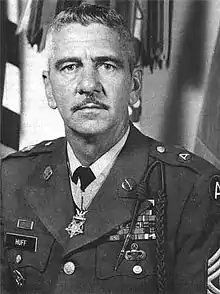Paul B. Huff
Paul Bert Huff[1] (June 23, 1918 – September 21, 1994) was a United States Army soldier and a recipient of the United States military's highest decoration—the Medal of Honor—for his actions in World War II.
Paul B. Huff | |
|---|---|
 Paul Bert Huff | |
| Born | June 23, 1918 Cleveland, Tennessee, US |
| Died | September 21, 1994 (aged 76) Cleveland, Tennessee |
| Buried | Hillcrest Memorial Gardens, Cleveland, Tennessee |
| Allegiance | United States |
| Service/ | United States Army |
| Rank | Command Sergeant Major |
| Unit | 509th Parachute Infantry Battalion |
| Battles/wars | World War II Vietnam War |
| Awards | Medal of Honor Legion of Merit (2) Bronze Star Medal (2) Air Medal (2) |
Military career
Huff joined the United States Army from his birth city of Cleveland, Tennessee, in June 1941,[2] and by February 8, 1944 was serving as a corporal in the 509th Parachute Infantry Battalion. On that day, near Carano, Italy, Huff led a reconnaissance patrol while under heavy fire from German forces. For his actions during the patrol, Huff received the Medal of Honor three months later, on May 26.
Medal of Honor citation
Corporal Huff's official Medal of Honor citation reads:
For conspicuous gallantry and intrepidity at risk of life above and beyond the call of duty, in action on 8 February 1944, near Carano, Italy. Cpl. Huff volunteered to lead a 6-man patrol with the mission of determining the location and strength of an enemy unit which was delivering fire on the exposed right flank of his company. The terrain over which he had to travel consisted of exposed, rolling ground, affording the enemy excellent visibility. As the patrol advanced, its members were subjected to small arms and machinegun fire and a concentration of mortar fire, shells bursting within 5 to 10 yards of them and bullets striking the ground at their feet. Moving ahead of his patrol, Cpl. Huff drew fire from 3 enemy machineguns and a 20mm. weapon. Realizing the danger confronting his patrol, he advanced alone under deadly fire through a minefield and arrived at a point within 75 yards of the nearest machinegun position. Under direct fire from the rear machinegun, he crawled the remaining 75 yards to the closest emplacement, killed the crew with his submachine gun and destroyed the gun. During this act he fired from a kneeling position which drew fire from other positions, enabling him to estimate correctly the strength and location of the enemy. Still under concentrated fire, he returned to his patrol and led his men to safety. As a result of the information he gained, a patrol in strength sent out that afternoon, 1 group under the leadership of Cpl. Huff, succeeded in routing an enemy company of 125 men, killing 27 Germans and capturing 21 others, with a loss of only 3 patrol members. Cpl. Huff's intrepid leadership and daring combat skill reflect the finest traditions of the American infantryman.
Before leaving the army, Huff reached the highest enlisted rank, command sergeant major, a position which carried the responsibilities of being the senior enlisted advisor to the commanding officer and a monitor for, and advocate of, the enlisted men in the command.
Death and legacy
Paul Huff died at age 76 and was buried in Hilcrest Memorial Gardens in his hometown of Cleveland, Tennessee. He was survived by his wife, Betty Cunnyngham Huff.
Paul Huff Parkway, a major thoroughfare in Cleveland, Tennessee, is named in his honor,[3][4] as is the Paul B. Huff Army Reserve Center, located in Nashville.
Notes
- "Hall of Valor".
- "NARA - AAD - Display Full Records - Electronic Army Serial Number Merged File, ca. 1938 - 1946 (Enlistment Records)". aad.archives.gov.
- "Command Sergeant Major (Retired) Paul B. Huff". 509thgeronimo.com. 509th Infantry Regiment. 2006. Retrieved November 3, 2017.
References
- "World War II Medal of Honor recipients (G–L)". Medal of Honor citations. United States Army Center of Military History. 2004-09-01. Retrieved 2007-04-17.
 This article incorporates public domain material from websites or documents of the United States Army Center of Military History.
This article incorporates public domain material from websites or documents of the United States Army Center of Military History.